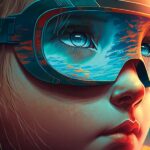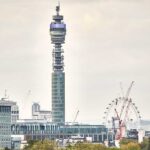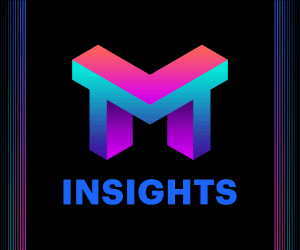Prepping for Paris 2024

Posted on May 10, 2024 by FEED Staff
Olympic games wide open
The French capital is readying itself for the triumphant, post-pandemic return of the Olympics. IP-driven broadcast production, cloud-based content delivery and AI-assisted storytelling will take centre stage
Words by Fergal Ringrose
The official slogan for Paris 2024, ‘Games Wide Open’, is ‘the shared slogan for both the Olympic Games and Paralympic Games,’ according to president of the Paris 2024 Olympic organising committee Tony Estanguet.
“It is an invitation to the world to come and experience new emotions together. New disciplines, outdoor competitions in the heart of Paris and a unique opening ceremony on the Seine,” Estanguet continues.
In a shift from tradition, the 2024 games will see many iconic Paris landmarks transformed into Olympic venues – rather than stadiums being built outside the city centre. “The concept of Paris 2024 will be very different and unique,” Estanguet tells NBC News. “It won’t be competitions into stadiums; it will be competitions into the city.”
Beach volleyball will be held under the unlikely location of the Eiffel Tower; fencing at the Grand Palais; archery at the Esplanade des Invalides; equestrian at Versailles; and brand-new Olympic sport breakdancing at Place de la Concorde.
In a less surprising move, Tennis will be held at the usual location for the French Open, Stade Roland-Garros, alongside boxing and some Paralympic events.
At the heart of the city, the river Seine will turn into the most important venue; home to an opening ceremony on the water, with 10,000 athletes from more than 200 counties parading down the river in a four-mile flotilla.
Triathlon and marathon swimming will also take place in the Seine after a massive clean-up operation – given that swimming in the river has been banned for over a century.
NBC Sports host Mike Tirico says, “The Olympic Games needed a boost, a refresh. Three in a row in Asia, two in a row with Covid-19 – a one-of-a-kind city is the perfect place to give it that boost.
“It’s going to add an energy the games need in general; 95% of the venues already exist making it rare and beneficial for long term sustainability. And for 100% of the venues, you can either take public transportation or walk. So this is a real ‘for the people’ Olympics.”
An Olympic first
The International Olympic Committee (IOC) is the owner of the global media rights for the Games and is responsible for allocating Olympic media rights to companies around the world.
Olympic Broadcasting Services (OBS) produces the TV, radio and digital coverage of the Olympic and Paralympic Games, including sports competitions plus the opening and closing ceremonies.
Beyond producing the live coverage, the key responsibilities for OBS are to aid the Media Rights-Holder (MRHs) operation, providing broadcasters with facilities and services at the International Broadcast Centre (IBC) and venues. OBS designs, builds and operates the IBC for each Olympic Games, while also ensuring the proper delivery of broadcast facilities at the venues.
Paris 2024 will be fully produced natively in UHD HDR, along with immersive 5.4.1 sound using more than 1000 camera systems and 3600 microphones.
Over double the amount of multicamera replay systems for freeze-frame slow motion replays will be provided compared to Tokyo 2020.
Additional sports will be provided with multi-clip feeds (MCF), offering broadcasters more content with increased replays, specialty camera shots and behind-the-scenes content such as athlete arrivals, warm-ups and venue atmosphere.
For the first time ever in Olympic broadcasting, cloud will be the main method of distribution, with delivery of the live signals over OBS Live Cloud – developed in partnership with IOC partner Alibaba.
OBS believes this will make accessing the content easier and affordable, being scaled up or down as required to meet demand. The bookings for cloud services by OBS are up 279% from Tokyo 2020.
Key innovations like this will also lead to a 13% reduction in IBC space compared to Tokyo, along with a 23% reduction from Rio 2016.
A decrease in power usage for broadcast at the IBC with a reduction of 44% compared to Tokyo and 72% decrease from Rio is anticipated. Venues will see an 11% reduction in compound space from Tokyo, coupled with a 29% reduction in venue broadcast power requirements compared to Tokyo, (46% decrease from Rio).
A record number of drones will take to the skies for live coverage, accompanied by more four-point systems than ever before. 5G will power onboard POV cameras for sailing events, with plans made to deploy additional 5G-enabled cameras for selected sports coverage and the opening ceremony.
Collaborating closely, OBS and NHK aim to deliver 8K live coverage of the opening ceremony and urban sports events.
Moreover, selected venues will feature virtual studio backdrops, alongside beauty camera positions. Augmented reality (AR) content and interviews from the Athletes’ Village will also be featured, designed for mobile phones but also usable with AR and VR headsets.
For Paris 2024, OBS is promising a cinematic approach to coverage, using cine lenses for the first time to provide a shallower depth-of-field. As part of aerial coverage, 12 beauty cameras will highlight the most iconic Paris images.

Trial run
In addition to sporting action, the Winter Youth Olympic Games (YOG) 2024 at Gangwon in South Korea also served as a sounding board for innovation and experimentation in the broadcasting and digital domains.
At an online media round table held in Gangwon, CEO of OBS Yiannis Exarchos shared: “How we use these Games is a great opportunity to test things that can potentially be implemented in the Olympic Games in Paris.
“YOG Gangwon sees the introduction of a virtualised broadcast van that mirrors the function of a traditional production van using software-based, cloud-driven technology instead of physical equipment – in collaboration with worldwide TOP partner Intel. We started this back in the Winter Games in 2022, with a successful proof of concept at curling. For Gangwon 2024, it is being used for live coverage for the first time on both curling and ice hockey.
“It’s a move away from traditional sports coverage on the ground with those huge OB vans we carry from place to place, which can sometimes be a little cumbersome and inflexible,” Exarchos expands. “So we have set up this innovative programme in the effort to create virtualised IP-based broadcast OB vans based on servers. This allows greater flexibility and a much smaller footprint in the venue using participation of production people around the world through a combination of virtualised processes and a lot of cloud services.
“The system has proven itself to be reliable; we will be using it in Paris for live coverage of judo/wrestling, tennis and shooting. We believe it is a great idea to make future broadcasting more efficient and sustainable,” continues Exarchos.
Two AI-based workflows were also tested at Gangwon that should make their way to Paris this summer. “With digital engagement, AI has been a road we have taken for a number of years,” adds Exarchos. “As technology rapidly matures, we are testing in Gangwon two important work streams. One has to do generation of automatic highlights; the other with AI assistance tools for the editors.
“For the Games in Paris, we currently plan to produce around 11,000 hours of content. This is much more than the duration of one full year. It’s a huge amount of content; obviously, to manage and produce customised highlights for different countries, athletes, sports, platforms, social media, vertical videos and so on, this requires a massive capacity to say the least.
“AI has started very credibly to produce this capability for us. This scaling is giving us and our rights holding broadcasters a lot of capacity and capabilities. Here in Gangwon, we are testing the proof of concept on ice hockey, which is going very well. We will be using automated highlights for 14 different sports in Paris,” he expands.
“The same goes for an AI system that helps editors with their stories, where markers are generated through the commentary associated with the live coverage. The system recognises key points said by the commentators and offers the important points in a competition, which can then be used in finished stories. In massive events which are complex and dense like the Games – where time
is of the essence – this is an incredibly useful tool.”

Olympic home in Europe
At IBC2023 in Amsterdam, Scott Young, senior vice president of content and production at Warner Bros Discovery Europe, along with Matt McDonald, senior vice president for EMEA broadcast services at Warner Bros Discovery, provided insight into the company’s plans to produce live coverage of all 329 events at Paris 2024.
“We are the home of the Olympics across Europe, and we’re counting down to the opening ceremony of Paris 2024,” begins Young. “Across Eurosport and TNT Sports in the UK, as well as our streaming products, the Olympic Games will come to life.
“Our role is to tell the story of the athletes in the competition. OBS delivers the global pictures which we broadcast, and we have two forms of entertainment. [First] the lean back experience, where our linear channels will bring you the very best of the Olympics – broadcasting in 47 markets in 19 languages.
“So depending on what market you’re in, we’ll curate the best of the Olympics on that linear channel to you. Or, you can lean forward through our streaming products and select the sport you want to watch from start to finish, as every sport is available live across our different products.”
“There are a lot of storytelling challenges,” adds McDonald. “How do we make sure every territory can see every feed, every camera? How do we make sure – from an audio point of view – we can deliver these 19 different languages and hundreds of commentary booths required across Europe to make that happen? And then, how do we provide a flexible infrastructure within that to share all our resources across EMEA?
“AI is something we’re looking heavily into at the moment. The question is, how do we use AI to help our staff be more productive and faster, enabling them to tell those stories?
“For this Olympics, we’ve got a set of new innovations. We have a cloud-based platform that enables us to be very sophisticated in terms of management of playlists and opting in and out of pans. We’ve a whole set of cloud-based technology we’re using to support production. On top of that, our whole cloud infrastructure is a massive SMPTE 2110 implementation that provides the scale and flexibility we need to make the Olympics happen.”
Ensuring fan engagement
Naturally, the Olympics also serve as a colossal money-making opportunity for advertising and extra fan engagement features.
“With the Olympics, you need to reach millions of people with the best quality possible,” begins Jean Macher, senior director for global SaaS solutions at Harmonic. “You need to ensure the platform you use is resilient and can provide a video pipeline. That’s what VOS360 is able to do.”
Harmonic’s VOS360 takes even the most complex workflow and abstracts it to a simple layer with guaranteed reliability.
Receive content at the source, uplink to the cloud, insert and personalise the content, then distribute to your viewer’s screen.
“When you have the Olympics – because it’s such a massive event with so many different live sports streams – you don’t want anything to go wrong. Because when it’s live, you have the blast radius, where if you have a problem anywhere in a chain, that can impact millions of people.”
Macher further emphasises that ensuring a high-quality viewer experience should be the top priority for networks and platforms that plan to broadcast the games.
“The platform you use must be resilient. For that, you need to build enough redundancy in your architecture so you can tackle problems as they come up. That means for viewers across separate regions in massive events like these – if you have enough redundancy and you lose an entire region – you’re still in business because another region is able to pick up that slack.
“VOS360 brings some unique features where we are able to synchronise different regions. It also has a cluster architecture in addition to being cloud native and all-elastic. Therefore if you lose a node, another pops up.
“Ultimately, the more the user experience is refined, the more likely it will lead to increased engagement. This will generate more monetisation opportunities. We offer targeted ad insertion in order to ensure the user is engaged even during a break.”
This feature was first published in the Spring 2024 issue of FEED.










